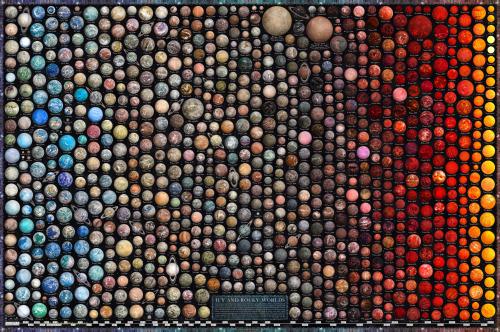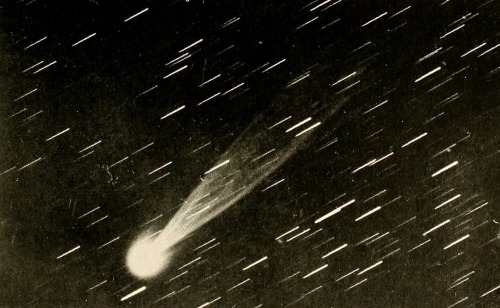WR 134, Cygnus



WR 134, Cygnus
More Posts from Ad-astra-affecte-spe and Others

The original Voyager 1 "Blue Movie" which records its approach during a period of over 60 Jupiter days (January 6 - February 3, 1979)



Hey. Why isn’t the moon landing a national holiday in the US. Isn’t that fucked up? Does anyone else think that’s absurd?


Over 800 terrestrial exoplanets visualized and arranged according to their equilibrium temperature and size.
chart by u/mVargic




Jupiter Swirling Storms l NASA Juno

Saturn and its amazing rings, observed by the Cassini probe on this day in 2004.




A beginner’s star-book, an easy guide to the stars and to the astronomical uses of the opera-glass, the field-glass and the telescope, 1912

Andromeda, If It Was Brighter
One of the largest structures in the night sky is visible with the naked eye, but if you live in a city, it's literally hiding just out of sight. Even in a dark area, it's not the easiest to immediately see, but the above image has brightened it up for us, to show us what the galaxy would look like, if only the sky was dark enough and the galaxy was a bit brighter.
The moon comparison is the best one, that is something we can all see in the night sky (unless you live in the UK, where you see mostly clouds).
Now imagine that galaxy stretching several moon-spans across the sky. That I hope gives you a minor taste of what it's like when using a small telescope or even binoculars, you first come across it.
If you live in the Northern Hemisphere, then it's well worth the search.

Near sunset, look for 3 objects which should be easy to locate, Venus and Jupiter (I'll come to this in a moment) low in the sky, the W of Cassiopeia and the Seven Sisters (Pleiades), and from that, you should find the location. Bare in mind it's several times the size of the moon, so you don't have to be too accurate, but if you can find the stars of Andromeda, that will help refine your search.

And finally that brings me on to the real star of the sky currently, Jupiter and Venus, the two brightest planets, very close together.
In fact, if you do have a really good pair of binoculars, or small telescope, this is a great time to view them. Venus often appears as a crescent like a phase of the moon, and Jupiter has it's 4 Galilean moons to spot.

Happy Spotting !

NGC 5189
NGC 5189 is a planetary nebula in the constellation Musca. It was discovered by James Dunlop on 1 July 1826, who catalogued it as Δ252. For many years, well into the 1960s, it was thought to be a bright emission nebula. It was Karl Gordon Henize in 1967 who first described NGC 5189 as quasi-planetary based on its spectral emissions
-
 carlottaragazzaloveeur reblogged this · 1 month ago
carlottaragazzaloveeur reblogged this · 1 month ago -
 carlottaragazzaloveeur liked this · 1 month ago
carlottaragazzaloveeur liked this · 1 month ago -
 pumpkinphrog liked this · 3 months ago
pumpkinphrog liked this · 3 months ago -
 ravilove1988 liked this · 4 months ago
ravilove1988 liked this · 4 months ago -
 roseoswiins reblogged this · 4 months ago
roseoswiins reblogged this · 4 months ago -
 feastofvsenses reblogged this · 4 months ago
feastofvsenses reblogged this · 4 months ago -
 siriusdoesthings liked this · 4 months ago
siriusdoesthings liked this · 4 months ago -
 oh-nostalgiaa liked this · 4 months ago
oh-nostalgiaa liked this · 4 months ago -
 missmendelsohn reblogged this · 4 months ago
missmendelsohn reblogged this · 4 months ago -
 ginsso reblogged this · 4 months ago
ginsso reblogged this · 4 months ago -
 gil-notskajla liked this · 4 months ago
gil-notskajla liked this · 4 months ago -
 jaggedlens reblogged this · 5 months ago
jaggedlens reblogged this · 5 months ago -
 indensternen reblogged this · 6 months ago
indensternen reblogged this · 6 months ago -
 cppu85 liked this · 6 months ago
cppu85 liked this · 6 months ago -
 this-is-a-love-story-isnt-it reblogged this · 6 months ago
this-is-a-love-story-isnt-it reblogged this · 6 months ago -
 opheliagreif liked this · 6 months ago
opheliagreif liked this · 6 months ago -
 rekishi-aka reblogged this · 6 months ago
rekishi-aka reblogged this · 6 months ago -
 m00nlight-raven liked this · 7 months ago
m00nlight-raven liked this · 7 months ago -
 desorbitad0 liked this · 7 months ago
desorbitad0 liked this · 7 months ago -
 hayday reblogged this · 7 months ago
hayday reblogged this · 7 months ago -
 mov33 liked this · 8 months ago
mov33 liked this · 8 months ago -
 carpethedamndiemdejavu liked this · 8 months ago
carpethedamndiemdejavu liked this · 8 months ago -
 breathe-expression reblogged this · 8 months ago
breathe-expression reblogged this · 8 months ago -
 cookieemonsterrr liked this · 8 months ago
cookieemonsterrr liked this · 8 months ago -
 cold-heart-legacy reblogged this · 8 months ago
cold-heart-legacy reblogged this · 8 months ago -
 prettylittleproblem reblogged this · 8 months ago
prettylittleproblem reblogged this · 8 months ago -
 brumbaughfett reblogged this · 8 months ago
brumbaughfett reblogged this · 8 months ago -
 t-iredeyes reblogged this · 8 months ago
t-iredeyes reblogged this · 8 months ago -
 n-yctophilie reblogged this · 8 months ago
n-yctophilie reblogged this · 8 months ago -
 drwormwithproblems reblogged this · 8 months ago
drwormwithproblems reblogged this · 8 months ago -
 mirrors-everywhere reblogged this · 8 months ago
mirrors-everywhere reblogged this · 8 months ago -
 ciruellas reblogged this · 9 months ago
ciruellas reblogged this · 9 months ago -
 buzzscot liked this · 9 months ago
buzzscot liked this · 9 months ago -
 elegant-delicacy reblogged this · 9 months ago
elegant-delicacy reblogged this · 9 months ago -
 cultural-derealization liked this · 9 months ago
cultural-derealization liked this · 9 months ago -
 silvereyedowl reblogged this · 9 months ago
silvereyedowl reblogged this · 9 months ago -
 cheeseburger-and-vine reblogged this · 9 months ago
cheeseburger-and-vine reblogged this · 9 months ago -
 the-ever-evolving-queendom liked this · 9 months ago
the-ever-evolving-queendom liked this · 9 months ago -
 txpuke liked this · 9 months ago
txpuke liked this · 9 months ago -
 rebel55 liked this · 9 months ago
rebel55 liked this · 9 months ago -
 itame84 liked this · 9 months ago
itame84 liked this · 9 months ago -
 hellodarjeeling reblogged this · 9 months ago
hellodarjeeling reblogged this · 9 months ago -
 v3nusb0und liked this · 9 months ago
v3nusb0und liked this · 9 months ago -
 cultural-derealization reblogged this · 9 months ago
cultural-derealization reblogged this · 9 months ago

★•Astronomy, Physics, and Aerospace•★ Original and Reblogged Content curated by a NASA Solar System Ambassador
204 posts